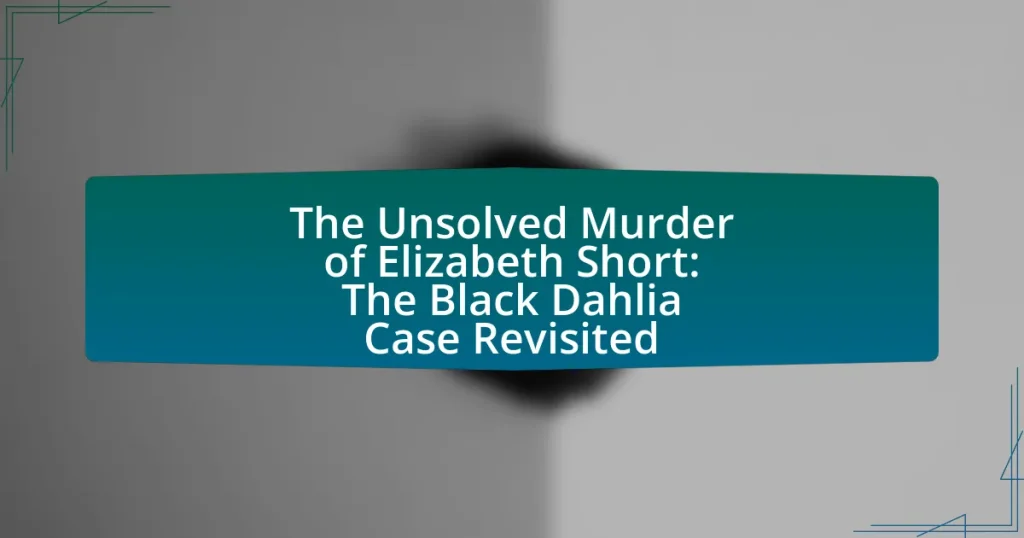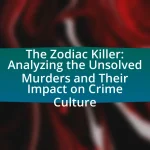The Black Dahlia Case refers to the unsolved murder of Elizabeth Short, a 22-year-old woman found dead in Los Angeles on January 15, 1947. Short’s body was discovered mutilated, leading to extensive media coverage and public fascination, making it one of the most infamous unsolved murders in American history. The article explores Elizabeth Short’s life, the circumstances of her murder, the challenges faced by investigators, and the evolution of theories surrounding her death. It also examines the impact of media sensationalism on public perception and the ongoing investigations that continue to draw interest in the case.

What is the Black Dahlia Case?
The Black Dahlia Case refers to the unsolved murder of Elizabeth Short, a 22-year-old woman found dead in Los Angeles on January 15, 1947. Short’s body was discovered mutilated and severed in two, leading to widespread media coverage and public fascination. The case remains one of the most infamous unsolved murders in American history, with numerous theories and suspects proposed over the decades, yet no one has been definitively charged. The name “Black Dahlia” was coined by the press, inspired by Short’s dark clothing and the film noir style prevalent at the time.
Who was Elizabeth Short and why is she significant?
Elizabeth Short was an American woman who became widely known as the “Black Dahlia” after her gruesome murder in 1947. Her significance lies in the sensational nature of her case, which remains one of the most famous unsolved murders in American history. The brutal circumstances of her death, including the manner in which her body was discovered in Los Angeles, captured public attention and led to extensive media coverage, influencing popular culture and crime investigation methods. The case has inspired numerous books, films, and theories, highlighting societal issues such as misogyny and the treatment of women in the media.
What were the circumstances surrounding Elizabeth Short’s life?
Elizabeth Short, known as the Black Dahlia, lived a tumultuous life marked by personal struggles and a quest for fame. Born on July 29, 1924, in Hyde Park, Boston, she faced a challenging childhood, including her father’s abandonment and her mother’s strict upbringing. Short moved to California in the early 1940s, where she sought to establish a career in acting but struggled to find success. Her life was characterized by transient living arrangements and tumultuous relationships, which contributed to her vulnerability. The circumstances of her life culminated in her brutal murder in January 1947, which remains one of the most infamous unsolved cases in American history. The media sensationalized her death, further entrenching her legacy as a tragic figure.
How did Elizabeth Short become known as the Black Dahlia?
Elizabeth Short became known as the Black Dahlia due to her posthumous association with the title, which originated from a 1947 film noir called “The Blue Dahlia.” The media coined the term “Black Dahlia” after her murder, emphasizing her dark clothing and the sensational nature of the case. The name gained traction as newspapers reported on her gruesome death and the investigation that followed, solidifying her identity in popular culture.
What are the key details of the murder case?
The key details of the murder case of Elizabeth Short, known as the Black Dahlia, include her body being discovered on January 15, 1947, in a vacant lot in Los Angeles, California. The body was severely mutilated, and the case garnered significant media attention due to the gruesome nature of the crime and the victim’s background. Elizabeth Short was a 22-year-old aspiring actress, and her murder remains unsolved despite numerous investigations and theories over the decades. The LAPD received hundreds of tips, but no definitive leads led to an arrest, making it one of the most famous unsolved murders in American history.
When and where did the murder of Elizabeth Short occur?
The murder of Elizabeth Short occurred on January 15, 1947, in Los Angeles, California. Short’s body was discovered in a vacant lot in the Leimert Park neighborhood, and the case gained significant media attention, leading to her being posthumously dubbed the “Black Dahlia.” The circumstances surrounding her death remain one of the most infamous unsolved murders in American history.
What were the findings of the initial investigation?
The initial investigation into the murder of Elizabeth Short, known as the Black Dahlia case, revealed that her body was discovered on January 15, 1947, in a vacant lot in Los Angeles, showing signs of severe mutilation and being drained of blood. The investigation uncovered that Short had been missing for several days prior to the discovery, and her body was cut in half at the waist, with her face disfigured. Additionally, the police received numerous tips and confessions, but none led to a definitive suspect, highlighting the case’s complexity and the challenges faced by law enforcement.
Why has the Black Dahlia case remained unsolved?
The Black Dahlia case has remained unsolved primarily due to a lack of concrete evidence and reliable witnesses. Investigators faced numerous challenges, including the absence of forensic technology available today, which hindered the ability to analyze physical evidence effectively. Additionally, the case was complicated by a plethora of false leads and numerous suspects, many of whom were never definitively linked to the crime. The media frenzy surrounding the case also led to public speculation that obscured the investigation, making it difficult for law enforcement to focus on viable leads. As a result, despite extensive investigations and numerous theories, the murder of Elizabeth Short remains one of the most infamous unsolved cases in American history.
What challenges did investigators face during the case?
Investigators faced significant challenges during the Black Dahlia case, primarily due to the lack of physical evidence and the overwhelming media attention that complicated the investigation. The crime scene was contaminated by numerous onlookers and reporters, which hindered the collection of crucial forensic evidence. Additionally, the case was marked by a plethora of false leads and tips from the public, further complicating the investigative process. The absence of reliable witnesses and the victim’s transient lifestyle made it difficult to establish a clear timeline or identify potential suspects. These factors collectively contributed to the case remaining unsolved despite extensive efforts by law enforcement.
How have theories about the murderer evolved over time?
Theories about the murderer in the Black Dahlia case have evolved significantly since Elizabeth Short’s murder in 1947. Initially, law enforcement focused on a range of suspects, including local criminals and individuals with mental health issues, reflecting the limited forensic technology of the time. Over the decades, as forensic science advanced, theories shifted towards more specific profiles, including the possibility of the murderer being a medical professional due to the precise nature of the mutilations.
In the 1980s and 1990s, new suspects emerged based on witness testimonies and circumstantial evidence, such as George Hodel, a physician whose son claimed he had confessed to the murder. This theory gained traction due to Hodel’s background and the circumstantial evidence linking him to the crime. More recently, advancements in DNA analysis have led to renewed interest in the case, prompting investigators to revisit old evidence and consider new suspects, although no definitive conclusions have been reached.
The evolution of these theories illustrates the impact of technological advancements and changing societal perspectives on crime and criminal psychology, highlighting the ongoing intrigue surrounding the Black Dahlia case.

What impact did the Black Dahlia case have on society?
The Black Dahlia case significantly impacted society by shaping public perceptions of crime and media sensationalism. The brutal murder of Elizabeth Short in 1947 captured national attention, leading to widespread media coverage that highlighted the darker aspects of urban life and crime in Los Angeles. This case became a symbol of the era’s fascination with violence and mystery, influencing how future crimes were reported and consumed by the public. The extensive media involvement also sparked discussions about the ethics of journalism, as sensationalist reporting often prioritized entertainment over factual accuracy. Consequently, the Black Dahlia case remains a pivotal moment in the history of crime reporting and societal attitudes towards unsolved murders.
How did media coverage shape public perception of the case?
Media coverage significantly shaped public perception of the Black Dahlia case by sensationalizing the details of Elizabeth Short’s murder and creating a narrative that captivated the public’s imagination. The extensive reporting by newspapers, particularly in Los Angeles, emphasized the gruesome aspects of the crime, portraying Short as a mysterious and tragic figure, which led to widespread fascination and speculation. This coverage not only influenced how the public viewed the case but also contributed to the mythologizing of Short, turning her into a cultural icon associated with the darker elements of Hollywood. The media’s portrayal often overshadowed the investigative efforts, leading to a perception that the case was more about the sensational story than about seeking justice for the victim.
What role did sensationalism play in the reporting of the Black Dahlia case?
Sensationalism played a significant role in the reporting of the Black Dahlia case by amplifying public interest and media coverage surrounding the murder of Elizabeth Short. The graphic nature of the crime, including the brutal dismemberment of her body, attracted extensive media attention, leading newspapers to publish sensational headlines and speculative stories that often lacked factual basis. For instance, the Los Angeles Herald-Express and other publications sensationalized the case by labeling Short as the “Black Dahlia,” a term that evoked intrigue and mystery, further fueling public fascination. This sensationalist approach not only shaped the narrative of the case but also influenced the investigation, as police received numerous tips and false confessions driven by the media frenzy.
How did the case influence crime reporting in the future?
The Black Dahlia case significantly influenced future crime reporting by highlighting the need for ethical standards and responsible journalism. The sensationalized coverage of Elizabeth Short’s murder led to public outcry over the media’s role in perpetuating myths and misinformation, prompting news organizations to adopt more rigorous guidelines. This case served as a catalyst for discussions on the impact of media on public perception of crime, ultimately resulting in a shift towards more factual reporting and sensitivity towards victims and their families.
What cultural significance does the Black Dahlia case hold today?
The Black Dahlia case holds significant cultural importance today as a symbol of unsolved mysteries and the darker aspects of American society. This case, involving the brutal murder of Elizabeth Short in 1947, has permeated popular culture, inspiring numerous films, books, and television shows, which reflect society’s fascination with crime and the macabre. The enduring interest in the case highlights issues such as media sensationalism, the treatment of women, and the complexities of law enforcement in high-profile investigations. Additionally, the Black Dahlia has become an archetype in discussions about the intersection of crime and celebrity, illustrating how unresolved cases can captivate public imagination for decades.
How has the Black Dahlia case been represented in popular culture?
The Black Dahlia case has been represented in popular culture through various mediums, including films, television shows, literature, and music. Notably, the case inspired the 2006 film “The Black Dahlia,” directed by Brian De Palma, which is based on James Ellroy’s novel of the same name. Additionally, the case has been referenced in numerous TV series, such as “American Horror Story: Hotel,” where Elizabeth Short’s story is woven into the narrative. Literature has also explored the case, with books like “The Black Dahlia Avenger” by Steve Hodel, which presents theories about the murder. The enduring fascination with the case reflects its impact on American culture, highlighting themes of mystery and the dark side of Hollywood.
What lessons can be learned from the Black Dahlia case regarding unsolved crimes?
The Black Dahlia case illustrates the importance of thorough investigative procedures and the impact of media sensationalism on unsolved crimes. The investigation into Elizabeth Short’s murder faced numerous challenges, including a lack of physical evidence and the overwhelming public interest that complicated the police’s efforts. This case highlights that unsolved crimes can result from inadequate forensic techniques available at the time, as well as the potential for misinformation to hinder investigations. Additionally, the Black Dahlia case serves as a reminder of the need for law enforcement agencies to maintain clear communication and collaboration to avoid the pitfalls of fragmented investigations, which can lead to missed opportunities for solving cases.

What are the ongoing investigations and theories surrounding the case?
Ongoing investigations into the murder of Elizabeth Short, known as the Black Dahlia case, include renewed interest from law enforcement and amateur sleuths alike, with various theories being explored. Current efforts involve the examination of cold case files, forensic advancements such as DNA analysis, and the re-evaluation of evidence collected at the crime scene in 1947. Theories surrounding the case range from the involvement of a serial killer to connections with organized crime, with some investigators suggesting that the murder may have been linked to a larger conspiracy. These theories are supported by historical accounts and witness testimonies that have emerged over the decades, indicating a complex web of potential suspects and motives.
What new evidence has emerged in recent years?
Recent years have seen the emergence of DNA evidence that may provide new insights into the unsolved murder of Elizabeth Short, known as the Black Dahlia case. In 2020, a team of forensic experts announced that they had successfully extracted DNA from evidence collected at the crime scene, including items like the victim’s clothing. This DNA analysis has the potential to identify new suspects or confirm the involvement of previously considered individuals. Additionally, advancements in genealogical DNA testing have allowed investigators to create family trees that could lead to the identification of the perpetrator, a method that has proven effective in other cold cases.
How have advancements in forensic science impacted the investigation?
Advancements in forensic science have significantly enhanced criminal investigations by improving evidence collection, analysis, and interpretation. Techniques such as DNA profiling, which became widely used in the 1990s, allow for the accurate identification of suspects and victims, thereby increasing the likelihood of solving cases like the Black Dahlia murder. Additionally, advancements in digital forensics enable investigators to recover and analyze data from electronic devices, providing crucial insights into criminal behavior and connections. The introduction of advanced imaging technologies, such as 3D scanning, has also improved crime scene reconstruction, allowing for a more thorough understanding of events. These innovations collectively contribute to a higher rate of case resolution and the potential for justice in previously unsolved cases.
What are the most credible theories about the identity of the murderer?
The most credible theories about the identity of the murderer of Elizabeth Short, known as the Black Dahlia, include the involvement of George Hodel, a physician who was a prime suspect due to circumstantial evidence and his connection to the Los Angeles area at the time of the murder. Hodel’s son, Steve Hodel, published a book titled “Black Dahlia Avenger,” presenting evidence such as photographs and witness testimonies that suggest his father was the killer. Another theory posits that the murderer was a serial killer, possibly linked to other unsolved cases in Los Angeles during the same period, as the brutality of the crime aligns with patterns seen in serial killings. Additionally, some investigators have speculated that the murderer could have been a member of the Hollywood elite, given Short’s connections to the film industry and the high-profile nature of the case. These theories are supported by various investigative reports and analyses conducted over the years, which highlight the lack of conclusive evidence pointing to a single suspect.
How do amateur sleuths contribute to the investigation of the Black Dahlia case?
Amateur sleuths contribute to the investigation of the Black Dahlia case by generating new theories, conducting independent research, and sharing findings that may lead to fresh insights. Their efforts often involve analyzing historical documents, interviewing witnesses, and utilizing online platforms to disseminate information. For instance, various amateur investigators have combed through police reports and media archives, uncovering overlooked details that could provide context or new leads. Additionally, the collective efforts of these individuals can foster public interest and awareness, potentially encouraging new witnesses to come forward, which is crucial in a case that remains unsolved since 1947.
What resources are available for those interested in investigating the case?
Resources available for those interested in investigating the Black Dahlia case include books, documentaries, and online databases. Notable books such as “The Black Dahlia” by James Ellroy provide fictionalized accounts based on the case, while “Black Dahlia, Red Rose” by Piu Eatwell offers a detailed historical analysis. Documentaries like “The Black Dahlia Murder” available on streaming platforms present visual insights into the investigation. Additionally, online databases such as the Los Angeles Public Library’s archives and the FBI’s Vault provide access to historical documents and case files related to Elizabeth Short’s murder, facilitating deeper research into the unsolved case.
How can public interest influence cold cases like the Black Dahlia?
Public interest can significantly influence cold cases like the Black Dahlia by generating renewed attention and resources for investigation. Increased public fascination often leads to media coverage, which can prompt law enforcement agencies to revisit unsolved cases, as seen with the Black Dahlia case, where ongoing public interest has led to the examination of new evidence and theories. For instance, the case has remained a topic of discussion in books, documentaries, and podcasts, keeping it alive in the public consciousness and encouraging amateur sleuths and professionals alike to contribute insights or tips. This sustained interest can also lead to advancements in forensic technology, as seen in other cold cases, where new methods have been applied to old evidence, potentially yielding new leads.
What can be done to keep the memory of Elizabeth Short alive?
To keep the memory of Elizabeth Short alive, public awareness initiatives can be implemented, such as educational programs and community events focused on her story. These initiatives can include documentaries, podcasts, and books that explore the details of her life and the circumstances surrounding her murder, which occurred in 1947. For instance, the ongoing interest in the Black Dahlia case has led to numerous media portrayals, ensuring that her story remains part of cultural discussions. Additionally, memorials or dedicated spaces in Los Angeles could serve as physical reminders of her legacy, fostering ongoing dialogue about unsolved crimes and their impact on society.
How can communities honor victims of unsolved crimes?
Communities can honor victims of unsolved crimes by organizing memorial events, creating awareness campaigns, and establishing dedicated memorials or plaques. These actions serve to keep the memory of the victims alive and highlight the ongoing search for justice. For instance, annual vigils can bring together families, friends, and community members to remember the victims and advocate for continued investigation efforts. Additionally, public art installations or community gardens can serve as lasting tributes, fostering a sense of remembrance and solidarity. Such initiatives not only honor the victims but also encourage dialogue about unsolved cases, potentially leading to new information or tips that could aid law enforcement.
What initiatives exist to support families of unsolved murder victims?
Initiatives that support families of unsolved murder victims include advocacy groups, victim support services, and cold case units within law enforcement agencies. Advocacy groups, such as the National Organization of Parents of Murdered Children, provide emotional support, resources, and guidance to families navigating the aftermath of a murder. Victim support services often offer counseling, legal assistance, and help with navigating the criminal justice system. Additionally, cold case units work to re-examine unsolved cases, providing families with hope for resolution and closure. These initiatives collectively aim to assist families in coping with their loss and seeking justice.

